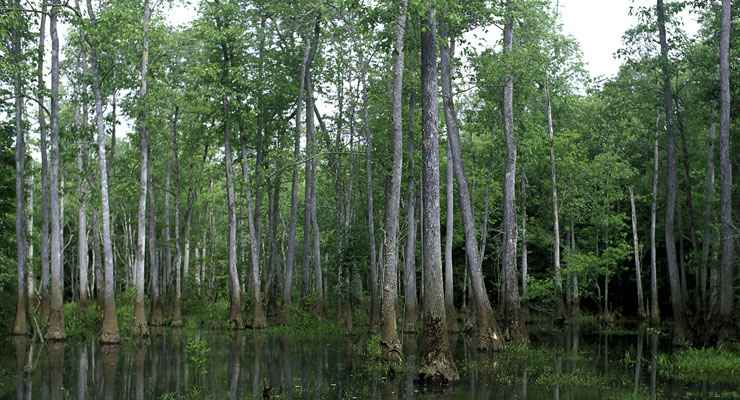Bond Swamp National Wildlife Refuge

Bond Swamp National Wildlife Refuge

Located about 6 miles south of Macon, Georgia, Bond Swamp National Wildlife Refuge straddles the fall line separating the Coastal Plains geological region from the Piedmont geological region. The Refuge was established in 1989 to protect the Ocmulgee River floodplain by maintaining and enhancing the local forested wetland ecosystem. On these 6,500 acres you'll find a diverse range of communities with creeks, tributaries, beaver swamps and oxbow lakes covered with mixed hardwoods and pines, bottomland hardwoods and tupelo gum swamp forests. For animals you're liable to come across black bear, alligator, white-tailed deer, wild turkey, wood duck, bald eagle and a large assortment of waterfowl. In the bottomland hardwoods you might also find neotropical songbirds of concern like yellow-billed cuckoo, prothonotary warbler, Swainson's warbler and wood thrush.
This is an area where the Ocmulgee River frequently overflows it banks, flooding and fertilizing the floodplain. This is a bit north for some reptiles but the area is wet enough and warm enough that you might come across alligators, rattlesnakes, copperheads and cottonmouths. You might also see green tree frog, eastern king snake, southern fence lizard, snapping turtle and box turtle. For mammals there are black bear, bobcat, raccoon, beaver, rabbit, white-tailed deer, muskrat, mink, river otter and various squirrels. The biggest environmental problem at Bond Swamp NWR comes from feral hogs introduced by the early European settlers. Feral hogs do really well in the refuge's bottomland hardwood forests and do extensive damage to the environment through their wallowing and rooting around in the muck and to the populations of wild turkey and other ground-nesting birds by trampling their nests and eating their eggs.
There are two hiking trails available on the Refuge. The Longleaf Pine Trail (1.9 miles one way) runs through a mixed pine/hardwood upland forest ecosystem. The Beaver Swamp Loop Trail (2 loops: 0.9 miles and 1.3 miles) runs through a bottomland hardwood forest alongside Stone Creek. Two things to be careful of all year round: ticks and chiggers. Both are especially bad in the summer and early fall. The poisonous snakes are most active in the spring and summer. Camping and campfires are not allowed anywhere on the property.
The Bond Swamp National Wildlife Refuge Visitor Center is located at the Piedmont National Wildlife Refuge in Jones County, about 30 miles north of Bond Swamp. To get to Bond Swamp itself, go south from Macon on Highways 23/129 for 4.2 miles (beyond Interstate 16) to the Bond Swamp National Wildlife Refuge sign at the Stone Creek entrance. Bond Swamp National Wildlife Refuge is open daily from sunrise to sunset although certain areas of the property may be closed due to flooding or because of deer or feral hog hunts.

Upper photo courtesy of John & Karen Hollingsworth, US Fish & Wildlife Service
Map and small photo courtesy of the US Fish & Wildlife Service